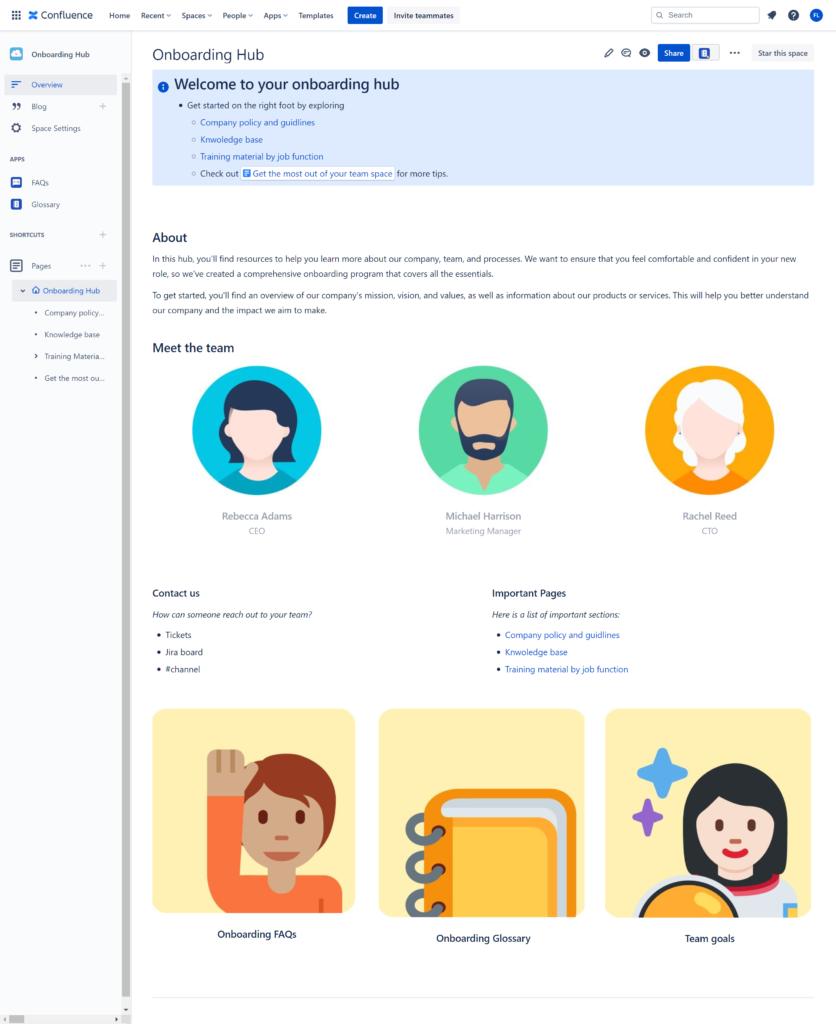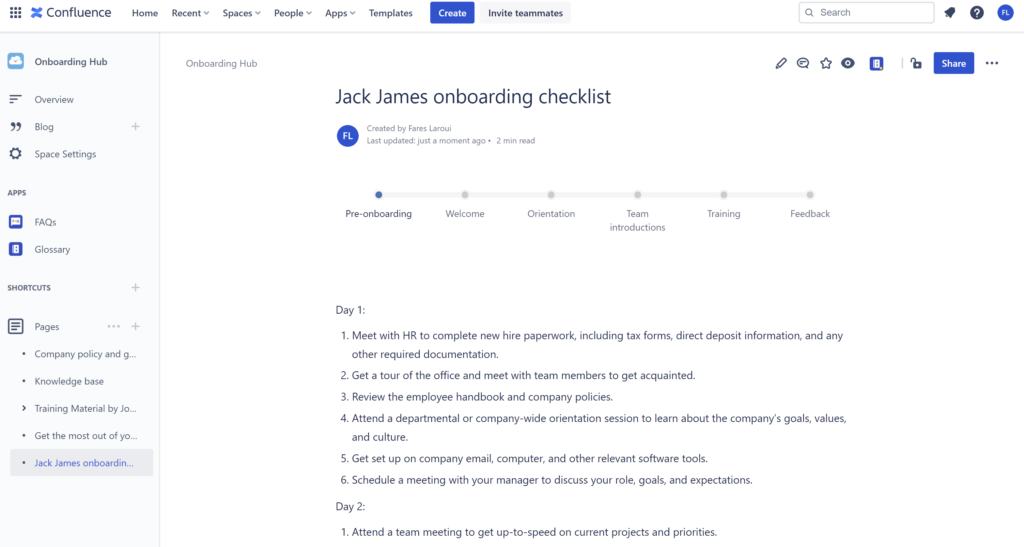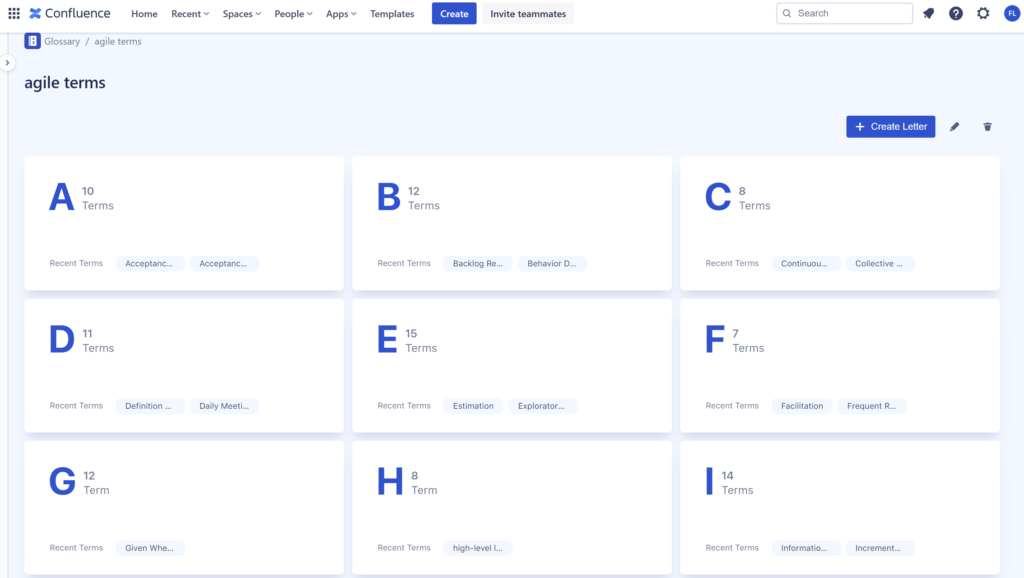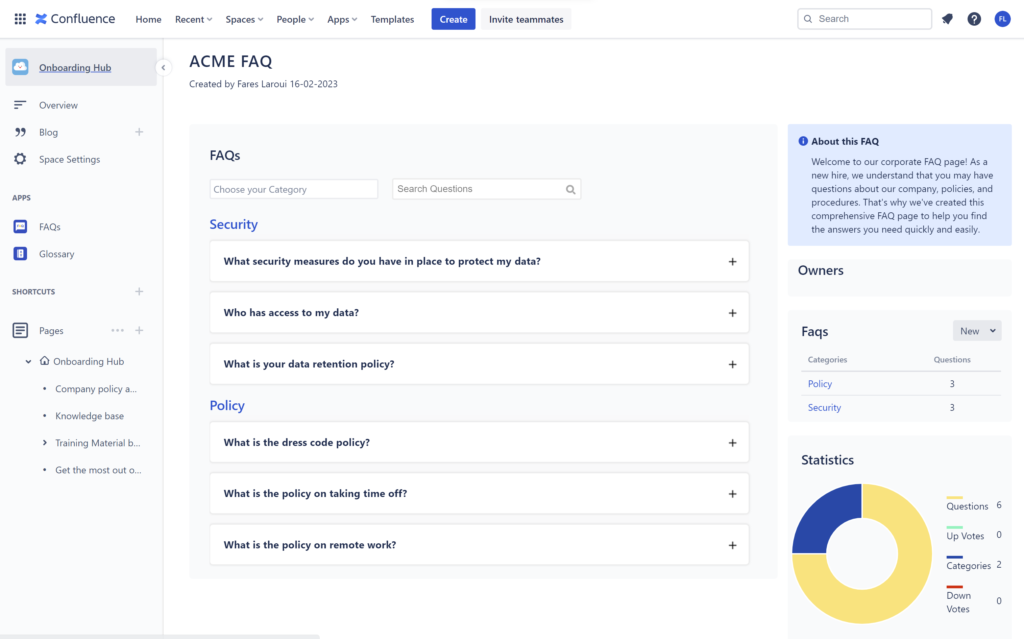Employee onboarding is perhaps one of the most critical challenges facing businesses today. Doing it right breeds a well informed and engaged workforce for both the short and long runs. However, overlooking this process can have its toll on engagement, productivity and performance.
Over the years, and especially after Covid, employee onboarding started to take place virtually. This is why we have seen many businesses rely on digital workplace solutions and collaborative platforms to facilitate the integration of their new hires. Among them, of course, is Confluence. Confluence’s content management, collaborative and social features are ideal to assist HR and team leaders effectively onboard new hires.
In this blog post, we will walk you through the steps to create a unified employee onboarding hub within Confluence.
Define your Onboarding Goals and Objectives
As is the case with any initiative in the workplace, it is important to define your goals and objectives right from the start. And employee onboarding is certainly no different. Diving head first into such a complex and tricky process is a recipe for disaster as it might lead your new hires to have a bad first impression of your business.
By defining your goals, you will be able to map your onboarding process, allocate the right resources (be it people or tools), and have a clear idea of the content you want to share and where.
Onboarding goals are more or less similar across businesses, but might differ depending on individual teams. Streamlining the onboarding process, educating new hires and relaying the company culture are a few goals that you should aim for.
Structure your Onboarding Hub
When structuring your onboarding hub, you should aim for simplicity, ease of access and navigation.
The obvious first step is to create a homepage for your onboarding hub. This will be the main page that new hires will land on when they first login to Confluence. Think of it as your typical welcome page where you can provide an overview of what the onboarding hub contains and how to navigate it.

Then leverage Confluence’s page trees and children pages to divide the onboarding hub into sections based on the different stages of onboarding or the different types of information that new employees will need. For example, you can create a main section dedicated to corporate info, and then separate sections based on teams or job functions. This way, if a marketing specialist joins your company, he/she can first access corporate info then navigate to the marketing section for more targeted content.
Decide on Which Content and Apps to Include in your Onboarding Hub
This leads us to the next step: the Confluence pages, or more specifically the content to include and how to structure their layout.
Once you have divided the onboarding hub into sections, create a separate page or a series of pages for each section. You can use these pages to provide more detailed information about each topic, such as a checklist for new hire paperwork, an overview of the company’s guidelines and training material. You can use labels to categorize and organize your pages within each section and further facilitate search.
– Pages layout
To properly structure and organize the layout of your Confluence pages, you can start with the formatting tools embedded within Confluence, including the WYSIWYG content editor. Use headings, bullet points, and other formatting features to make the onboarding hub easy to navigate.
You can also opt for specialized formatting apps like Vectors Content Formatting for Confluence. The app consists of a host of macros designed to enhance your onboarding hub layout, document and track processes, and more.
For example, the progress bar macro, allows you to create detailed processes and associate each page with a specific step. This way the new hire can assess the progress made and have an overview of the remaining steps.

– Content ideas you might want to consider including glossaries and FAQs
A Glossary integrated within Confluence can be a powerful tool for new hires, especially those who are unfamiliar with the company’s industry-specific terminology.
The Glossary can be used to define key terms, providing new hires with the knowledge they need to get proficient quickly. With a centralized glossary, new hires can easily access key terminologies across Confluence. This allows new hires to focus on learning about their roles and responsibilities without getting bogged down in terminology or acronyms that they don’t understand.
Additionally, with a unified glossary, knowledge can be shared across the organization, ensuring everyone speaks the same language. This not only benefits new hires but also benefits other employees who may not be familiar with specific terms. As a result, the glossary can foster a culture of knowledge sharing and collaboration, further strengthening the organization’s onboarding process.

On the other hand, FAQ pages can be an incredibly useful tool for new hires. They are designed to help employees find answers to their most frequently asked questions without having to spend time looking for people with answers. This saves new hires time and helps them quickly find the information they need.

FAQs can be structured in many ways, but it’s essential to ensure that they are easily accessible and understandable. Categorizing FAQs according to relevant topics, such as HR policies, IT services, or company culture, can make it easier for new hires to find the answers they need.
Set Permissions and Restrictions
Now that you have an overall idea of your onboarding hub structure and the content you wish to include, the next step is to set permissions. With a host of sections and pages already created, you need to carefully associate them with the right audience. This is crucial especially when it comes to specific team or new hire pages that contain sensitive or confidential information. Luckily, Confluence is well-equipped to help you easily manage permissions and show the right content to the right audience.
Test your Onboarding Hub Before Launching
Before launching the onboarding hub, test it with a small group of new employees and gather usage feedback. Then, use the data collected to refine the hub and make any necessary changes. For example,some early adopters might still have unanswered questions or terms they couldn’t find within glossaries. You can relay their feedback to the Onboarding hub managers to update the affected pages.
Launch and Assess Key Metrics
Once the hub is ready, launch it to all new employees and continue to assess usage and engagement metrics by using the built-in Analytics module within Confluence. You can have a detailed view of page views, most popular content, frequent contributors and more. Additionally, make sure to update the onboarding hub with the latest information and resources. Consider creating a feedback mechanism so employees can share their thoughts and suggestions for improving the onboarding experience.
In conclusion, building an employee onboarding hub in Confluence is a great way to streamline your onboarding process and ensure that new hires have all the information they need to succeed in their new role. By creating a central location for training materials, policies, and other resources, you can help new hires get up to speed quickly and efficiently, while also reducing the workload on your HR and management teams.